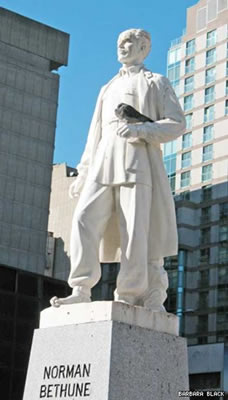
Back to archives | Back to FOFA Gallery
|
Crossing Cultures: Images of Norman Bethune in China
October 6 – 31
For thirty years a large marble statue of Dr. Norman Bethune (1890-1939) dominated the small traffic-island park at the juncture of de Maisonneuve Boulevard and Guy Street in downtown Montreal. This month it is being moved a few meters to the redesigned Place Norman-Bethune in the heart of the Quartier Concordia. A gift of the Government of the People’s Republic of China to the City of Montreal, the sculpture was one of many initiatives that followed the reopening of official relations between China and Canada. The monument celebrates an individual who figured large in medical, political and cultural circles in Montreal during the 1930s. He later went to China and worked as a battlefield surgeon alongside the Eighth Route Army during the War of Resistance Against Japanese Aggression.
Bethune, an unconventional thoracic surgeon and an organizer of a free art school for Montreal children, was among the earliest advocates of socialized medicine in Canada. He joined the Canadian Communist Party in 1935. Not surprisingly his memory was marginalized in Canada until the early 1970s. His fate in China, where he had died in November 1939, was very different. When Si Tu Jie and a team of sculptors took up the production of the statue for Montreal in the 1970s, they were confronted by Bethune’s legend. He had been highly regarded during the many grueling months he spent supporting Chinese Communist troops and setting up a medical infrastructure for the army. Within a month of his death from the complications of a surgical accident, the famed doctor was the subject of Chairman Mao Zedong’s In Memory of Norman Bethune. This text, contrasting the Canadian’s “utter devotion to others without any thought of self” with those who “feel no warmth towards comrades and the people but are cold, indifferent and apathetic,” was widely read in the years following its publication and became prescribed reading for school children in the early 1960s. Extracts were also included in the Quotations of Chairman Mao, the famous “little red book” that was printed in billions of copies and distributed all over the world. As a result, Bethune was defined at the highest levels as an internationalist worthy of emulation by the masses.
To mark the restoration and rededication of Montreal’s statue of Bethune, a selection of photographs generously provided by the Embassy of the People’s Republic of China, working in conjunction with the Ministry of Culture and the Ministry of Education of the People’s Republic, is on display at the FOFA Gallery of Concordia University. These journalistic photographs were part of the effort
in the late 1930s to gain support for the struggle against Japan and for the Chinese Communist Party. Also included in this exhibition are more recent representations of Norman Bethune. Reproductions of posters from 1966-1976, as well as an enlargement of a 1965 photograph showing a group of porcelain workers in Fushan admiring one of their Bethune creations, are faint traces of the millions of visual representations of the Canadian hero in circulation during that era. Two copies of a bust of Bethune, especially created for this exhibition, also remind us of the respect Baiqiuen (as he is known in China) continues to command to this very day. —Dr. Catherine MacKenzie,
Department of Art History, Concordia University
NORMAN BETHUNE AND VISUAL CULTURE(S): A SYMPOSIUM
OCTOBER 18, 2008
York Auditorium, EV-1.605 and EV-1.615
1515 St. Catherine St. West, Montreal
Free Admission. No Reservations Needed.
 
|
|



